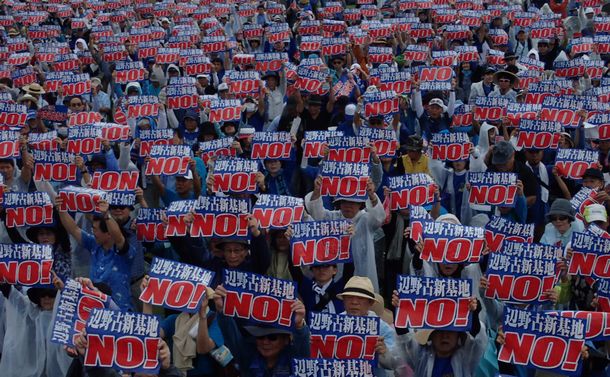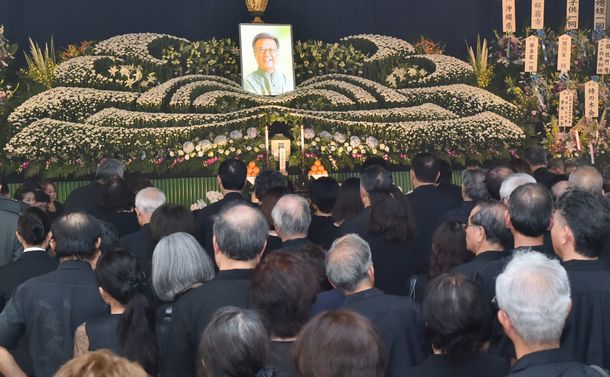Why Onaga became a critic of GOJ
2018年08月17日
 Protesters held up signs saying “Henoko new base, NO!” in Naha, Aug. 11 2018
Protesters held up signs saying “Henoko new base, NO!” in Naha, Aug. 11 2018On 11th August, about 70,000 people gathered at a park in Naha, the prefectural capital of Okinawa, organized by “The All Okinawa Center to Stop the Planned Relocation of U.S. Marine Corps Air Station Futenma” under pouring rain ahead of an approaching typhoon. Based on the SACO agreement between the U.S. and Japanese government in 1996, the Government of Japan has planned to move Futenma Air Station from a crowded neighborhood to a less populated coastal site within Okinawa.
Exposed to rain and the noise from right-wing sound trucks surrounding the park, the participants consisting of all ages observed a moment of silence for Okinawa’s governor, Takeshi Onaga, who died of cancer on 8th August. Most participants wore black ribbon around their arms to express their deep sorrow over Onaga’s death.
The son of Governor Onaga and a Naha city assembly member Takeharu Onaga criticized GOJ for ignoring the voice of opposition to the Futenma relocation by Okinawans and encouraged the participants to continue the battle against the planned relocation following in Governor Onaga’s footsteps. In addition, Deputy Governor Kiichiro Jahana pledged that he would follow through with the revocation process of a landfill permit instructed by the governor. The landfill permit was issued by Onaga’s predecessor for construction of the Futenma relocation facility under pressure from GOJ in the end of 2013, which made Mr. Onaga decide to run for the 2014 election of Okinawa Prefectural Governor to confront GOJ on the Futenma relocation.
 The funeral of Okinawa's Governor Takeshi Onaga was held in Naha, Aug.13 2018
The funeral of Okinawa's Governor Takeshi Onaga was held in Naha, Aug.13 2018Governor Onaga has been known for the protest to the Futenma relocation and the criticism of GOJ for ignoring Okinawa’s public opinion since his winning with 100,000 votes on the 2014 election. However, what we know about Onaga was exceptional image all through his life. Since elected as a Naha city assembly member in 1985, Mr. Onaga had belonged to the Liberal Democratic Party for about thirty years and experienced several significant positions of the Okinawa LDP chapter such as secretary general. Mr. Onaga had been loyal to the LDP that he had supported for the Futenma relocation on the SACO (Special Action Committee on Okinawa) agreement during 1990s and the beginning of 2000s. What changed Onaga’s loyal to the LDP and his political position?
The event that Mr. Onaga left a strong impression with his protest against GOJ for the first time was the deployment of MV-22 Osprey aircraft to the Futenma Air Station in October 2012. Mr. Onaga, the Mayor of Naha City at that time, criticized the government under rule of the Democratic Party of Japan and demanded the cancel of the Osprey’s deployment. In January 2013, after the DPJ was defeated in the 2012 Lower House election and the second Shinzo Abe Administration was established, Mr. Onaga organized a protest group consists of 140 local statesmen all over Okinawa to march to protest against Osprey’s deployment and demand the withdrawal of the U.S. aircraft from Okinawa at the heart of Tokyo.
Actually, Osprey’s deployment to Okinawa was not the only motive of Mr. Onaga for confrontation with GOJ under the LDP’s rule. The buildup of betrayal by the LDP for a long time strained Onaga’s patience to the breaking point.
Takeshi Onaga was born in 1950, in the coastal city of Naha, when Korean War broken out and the U.S. occupation force expanded the military bases in Okinawa. Takeshi’s father was also a mayor of Naha City (Mawashi City in those days), and his older brother was a deputy governor. Takeshi decided to run for mayor of Naha City in the future when he was 12 years old. Graduating from Naha High School famous as a prestigious school, Takeshi left Okinawa for entering Hosei University in Tokyo.
Okinawa had been under U.S. military occupation from 1945 to 1972, 20 years longer than American postwar occupation of the Japanese mainland, therefore Takeshi had to have a passport to “study abroad” in the mainland of Japan. GOJ had sought for the reversion of Okinawa and provided financial aid for young people in occupied Okinawa to go to a university in the Japanese mainland since 1948, Takeshi was also educated at Hosei under GOJ’s fellowship.
The young man born into a distinguished political family experienced discrimination against Okinawans in Tokyo and had difficulty finding an apartment, which he never forgot. As young Onaga attended Hosei University, there was a student named Yoshihide Suga, who is destined to become Abe’s chief cabinet secretary and confront Governor Onaga, at the university.
有料会員の方はログインページに進み、デジタル版のIDとパスワードでログインしてください
一部の記事は有料会員以外の方もログインせずに全文を閲覧できます。
ご利用方法はアーカイブトップでご確認ください
朝日新聞社の言論サイトRe:Ron(リロン)もご覧ください